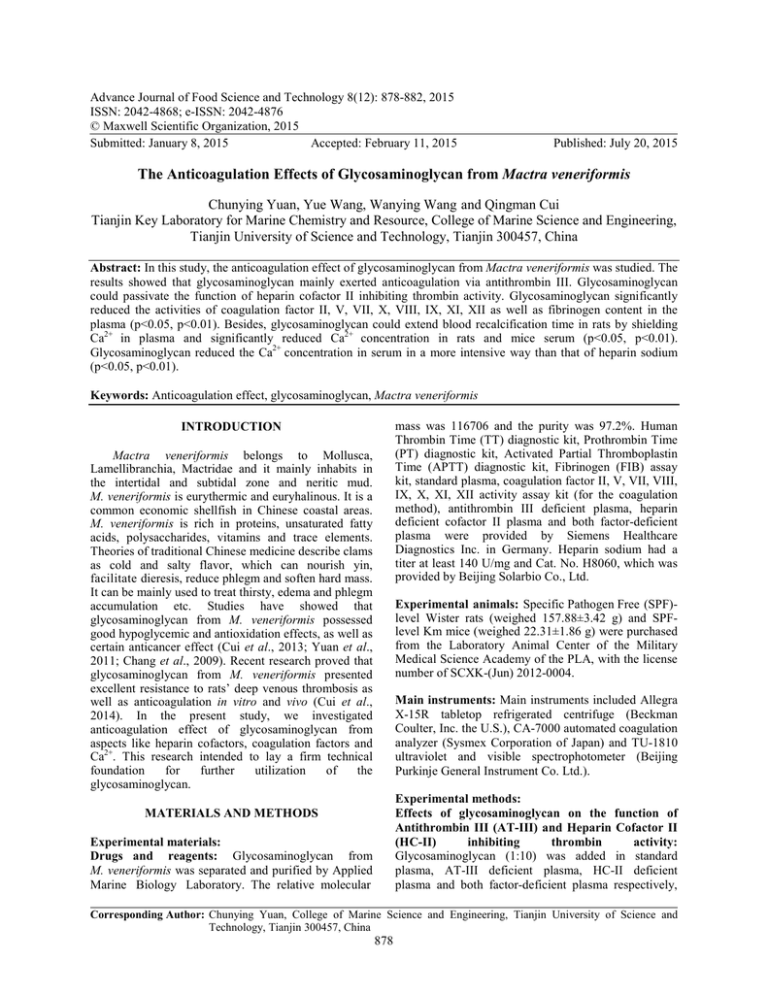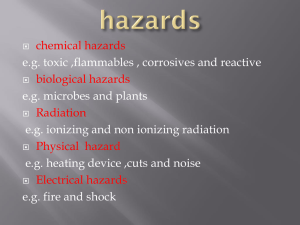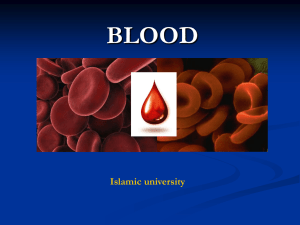Advance Journal of Food Science and Technology 8(12): 878-882, 2015
advertisement

Advance Journal of Food Science and Technology 8(12): 878-882, 2015 ISSN: 2042-4868; e-ISSN: 2042-4876 © Maxwell Scientific Organization, 2015 Submitted: January 8, 2015 Accepted: February 11, 2015 Published: July 20, 2015 The Anticoagulation Effects of Glycosaminoglycan from Mactra veneriformis Chunying Yuan, Yue Wang, Wanying Wang and Qingman Cui Tianjin Key Laboratory for Marine Chemistry and Resource, College of Marine Science and Engineering, Tianjin University of Science and Technology, Tianjin 300457, China Abstract: In this study, the anticoagulation effect of glycosaminoglycan from Mactra veneriformis was studied. The results showed that glycosaminoglycan mainly exerted anticoagulation via antithrombin III. Glycosaminoglycan could passivate the function of heparin cofactor II inhibiting thrombin activity. Glycosaminoglycan significantly reduced the activities of coagulation factor II, V, VII, X, VIII, IX, XI, XII as well as fibrinogen content in the plasma (p<0.05, p<0.01). Besides, glycosaminoglycan could extend blood recalcification time in rats by shielding Ca2+ in plasma and significantly reduced Ca2+ concentration in rats and mice serum (p<0.05, p<0.01). Glycosaminoglycan reduced the Ca2+ concentration in serum in a more intensive way than that of heparin sodium (p<0.05, p<0.01). Keywords: Anticoagulation effect, glycosaminoglycan, Mactra veneriformis mass was 116706 and the purity was 97.2%. Human Thrombin Time (TT) diagnostic kit, Prothrombin Time (PT) diagnostic kit, Activated Partial Thromboplastin Time (APTT) diagnostic kit, Fibrinogen (FIB) assay kit, standard plasma, coagulation factor II, V, VII, VIII, IX, X, XI, XII activity assay kit (for the coagulation method), antithrombin III deficient plasma, heparin deficient cofactor II plasma and both factor-deficient plasma were provided by Siemens Healthcare Diagnostics Inc. in Germany. Heparin sodium had a titer at least 140 U/mg and Cat. No. H8060, which was provided by Beijing Solarbio Co., Ltd. INTRODUCTION Mactra veneriformis belongs to Mollusca, Lamellibranchia, Mactridae and it mainly inhabits in the intertidal and subtidal zone and neritic mud. M. veneriformis is eurythermic and euryhalinous. It is a common economic shellfish in Chinese coastal areas. M. veneriformis is rich in proteins, unsaturated fatty acids, polysaccharides, vitamins and trace elements. Theories of traditional Chinese medicine describe clams as cold and salty flavor, which can nourish yin, facilitate dieresis, reduce phlegm and soften hard mass. It can be mainly used to treat thirsty, edema and phlegm accumulation etc. Studies have showed that glycosaminoglycan from M. veneriformis possessed good hypoglycemic and antioxidation effects, as well as certain anticancer effect (Cui et al., 2013; Yuan et al., 2011; Chang et al., 2009). Recent research proved that glycosaminoglycan from M. veneriformis presented excellent resistance to rats’ deep venous thrombosis as well as anticoagulation in vitro and vivo (Cui et al., 2014). In the present study, we investigated anticoagulation effect of glycosaminoglycan from aspects like heparin cofactors, coagulation factors and Ca2+. This research intended to lay a firm technical foundation for further utilization of the glycosaminoglycan. Experimental animals: Specific Pathogen Free (SPF)level Wister rats (weighed 157.88±3.42 g) and SPFlevel Km mice (weighed 22.31±1.86 g) were purchased from the Laboratory Animal Center of the Military Medical Science Academy of the PLA, with the license number of SCXK-(Jun) 2012-0004. Main instruments: Main instruments included Allegra X-15R tabletop refrigerated centrifuge (Beckman Coulter, Inc. the U.S.), CA-7000 automated coagulation analyzer (Sysmex Corporation of Japan) and TU-1810 ultraviolet and visible spectrophotometer (Beijing Purkinje General Instrument Co. Ltd.). Experimental methods: Effects of glycosaminoglycan on the function of Antithrombin III (AT-III) and Heparin Cofactor II (HC-II) inhibiting thrombin activity: Glycosaminoglycan (1:10) was added in standard plasma, AT-III deficient plasma, HC-II deficient plasma and both factor-deficient plasma respectively, MATERIALS AND METHODS Experimental materials: Drugs and reagents: Glycosaminoglycan from M. veneriformis was separated and purified by Applied Marine Biology Laboratory. The relative molecular Corresponding Author: Chunying Yuan, College of Marine Science and Engineering, Tianjin University of Science and Technology, Tianjin 300457, China 878 Adv. J. Food Sci. Technol., 8(12): 878-882, 2015 normal saline was added in the control group and the concentration of glycosaminoglycan was 4 mg/mL. After 5 min, PT and TT reagents pre-incubated for 15 min were added and the coagulation factor analyzer was used to measure the coagulation time. each of which had 10 mice. (0.12 mL) of blood was taken from posterior orbital venous plexus with the treated capillaries and centrifuged at 3000 rpm for 10 min. The Ca2+ concentration in serum was measured by MTBC method. Effects of GAG on the activity of coagulation factors in human plasma: The activities of coagulation factor II, V, VII, VIII, IX, X, XI, XII and the fibrinogen content were measured according to the instructions of assay kits. Three concentrations of glycosaminoglycan (50, 100 and 200 µg/mL, respectively) were selected. The heparin sodium concentration was 50 µg/mL and the control group was normal saline. Statistical analysis: All the experimental data was analyzed by One-Way ANOVA. The analysis software was SPSS 17. 0. The experimental data was expressed by mean ± S.D. RESULT ANALYSIS Effects of glycosaminoglycan on AT-III and HC-II inhibiting thrombin activity: The results were shown in Table 1. After the addition of glycosaminoglycan in standard plasma, AT-III deficient plasma, HC-II deficient plasma and both factor-deficient plasma, TT and PT extended significantly (p<0.05, p<0.01). Compared with standard plasma plus GAG group, ATIII deficient plasma plus GAG and both factor-deficient plasma plus GAG groups significantly reduced TT and PT (p<0.05, p<0.01) and TT extended significantly after the addition of glycosaminoglycan in HC-II deficient plasma (p<0.01). It was inferred that there were different anticoagulation approaches from heparin. Effects of glycosaminoglycan on blood recalcification time of rats in vitro: A total of 6 Wistar rats were used for experiment. Two concentrations of calcium chloride (10 and 3 mg/mL) were selected. The glycosaminoglycan concentrations were 1, 2 and 4 mg/mL, respectively. The normal saline and heparin sodium (1 mg/mL) were used as control and positive control groups. Blood samples were withdrawn from arteria femoralis in rats and anticoagulated with 5% potassium oxalate solution (50:1, v/v) and then 0.9 mL of plasma and 0.1 mL of different concentrations glycosaminoglycan, normal saline and heparin sodium (1 mg/mL) were added in centrifuge tubes respectively and then 0.1 mL of different concentrations calcium chloride solution were added. The mixed solutions were processed with waterbath at 37°C and the centrifuge tubes were slightly tilted every 30 sec, when the blood was not flowing in the centrifuge tube, the time was recorded and expressed by seconds. Impact of glycosaminoglycan on coagulation factors activities in human plasma: The activities of coagulation factor II, V, VII, X, VIII, IX, XI and XII were measured via correcting the ability of coagulation time extension caused by factor deficient plasma and expressed by percentage (%). The Fibrinogen (FIB) content was determined by the coagulation method and the results were shown in Table 2. FIB content in the heparin sodium group was obviously higher than the control group, but did not reach a significant level (p>0.05). FIB content in glycosaminoglycan groups of different concentrations did not present significant difference from the control group. Glycosaminoglycan and heparin sodium could significantly reduce the activities of coagulation factor II, V, VII, VIII, IX, X, XI and XII (p<0.05, p<0.01). The ability of glycosaminoglycan in reducting the activities of coagulation factor IX, XI and XII was significantly lower than that of heparin sodium (p<0.05, p<0.01). The ability of glycosaminoglycan in diminishing the activities of coagulation factor II, V, VII and VIII was obviously weaker than that of heparin sodium. The ability of glycosaminoglycan in reducing the activity of coagulation factor X was slightly stronger than that of heparin sodium. Impact of glycosaminoglycan on Ca2+ concentration in rats serum: A total of 36 Wistar rats were randomly divided into 6 groups, six rats in each group. After 6 days of normal feeding, rats were treated with caudal vein injection of glycosaminoglycan (1, 4 and 16 mg/kg, respectively), heparin sodium (4 mg/kg) and normal saline respectively, the injection volume was 0.5 mL. After 30 min, the blood was collected via arteria femoralis and centrifuged at 3000 rpm for 15 min. The serum was prepared. Methyl Thymol Blue Colorimetric (MTBC) method was used to Measure Ca2+ concentration in the serum (Ye et al., 1997). Effects of glycosaminoglycan on Ca2+ concentration in serum during blood collectin from posterior orbital venous plexus in mice: Capillary pipettes were immersed in 1, 2 and 4 mg/mL, respectively glycosaminoglycan, 2 mg/mL heparin sodium (the positive control group) and normal saline (the control group) for 24 h respectively and then dried for further use. Sixty mice were randomly divided into 6 groups, Effects of glycosaminoglycan on recalcification coagulation time in vitro: Compared with the control group, in addition to the low concentration of 879 Adv. J. Food Sci. Technol., 8(12): 878-882, 2015 Table 1: Effects of glycosaminoglycan on the function of AT-III and HC-II inhibiting thrombin activity Groups TT (sec) PT (sec) Standard plasma 14.05±1.03 12.87±1.07 Standard plasma+GAG 127.22±16.26** 23.63±4.65** AT-III deficient plasma 12.87±1.23 11.92±1.26 aadd AT-III deficient plasma+GAG 20.03±2.62 16.85±2.91aad HC-II deficient plasma 13.35±0.99 11.85±1.63 HC-II deficient plasma+GAG 168.13±21.16bbdd 25.57±3.81bb Both factor-deficient plasma 13.05±1.23 11.67±1.15 Both factor-deficient plasma+GAG 23.13±4.89ccdd 15.22±2.49cdd aa Data are mean±S.D.; Compared with standard plasma, **: p<0.01; Compared with AT-III deficient plasma, : p<0.01; Compared with HC-II deficient plasma, bb: p<0.01; Compared with both factor-deficient plasma, c: p<0.05; cc: p<0.01; Compared with standard plasma+GAG, d: p<0.05; dd : p<0.01 Table 2: Effects of glycosaminoglycan on coagulation factor activities in plasma Coagulation GAG GAG factors Control group Heparin sodium (50 µg/mL) (100 µg/mL) FIB (g/L) 2.44±0.31 2.15±0.22 2.41±0.27 2.35±0.26 Factor II 101.76±6.18 52.79±7.17** 63.49±11.37** 61.19±12.90** Factor V 103.13±8.75 35.26±6.32** 49.02±6.96**a 45.72±7.73** Factor VII 102.72±14.59 51.94±10.22** 66.41±9.36** 60.97±8.98** Factor VIII 102.69±13.80 45.62±4.58** 50.59±8.75** 50.57±6.66** Factor IX 101.52±11.84 34.43±4.72** 63.73±9.10**aa 59.74±7.52**aa Factor X 104.23±16.47 58.69±7.99** 54.76±10.39** 53.85±7.27** Factor XI 102.91±11.74 21.94±1.85** 85.91±8.17**aa 69.51±9.22**aa aa 70.43±10.92**aa Factor XII 99.66±12.69 10.08±1.63** 80.57±11.18* Data are mean±S.D.; Compared with control group, *: p<0.05; **: p<0.01; Compared with heparin sodium; a: p<0.05; aa: p<0.01 GAG (200 µg/mL) 2.38±0.35 57.39±8.96** 46.88±7.74**a 56.91±9.07** 51.37±7.88** 61.18±6.34**aa 55.21±9.99** 65.46±8.09**aa 64.65±12.16**aa Table 3: Effects of glycosaminoglycan on blood recalcification time of rats in vitro Groups Calcium chloride (3 mg/mL) Calcium chloride (10 mg/mL) Control group 107.33±11.76 67.83±7.86aa GAG (1 mg/mL) 164.67±11.69** 91.83±9.52aa GAG (2 mg/mL) 205.83±12.11** 148.83±10.21**aa GAG (4 mg/mL) 242.83±10.36** 171.67±7.47**aa Heparin sodium 655.67±60.19** 490.67±35.70**aa Data are mean±S.D.; Compared with control group; **: p<0.01; Compared with 3 mg/mL calcium chloride; aa: p<0.01 Table 4: Effect of glycosaminoglycan on Ca2+ concentration in rats serum Groups Control group Heparin sodium GAG (1 mg/mL) GAG (4 mg/mL) Time (sec) 2.926±0.148 2.661±0.159* 2.282±0.210**aa 2.038±0.199**aa Data are mean±S.D.; Compared with control group; *: p<0.05; **: p<0.01; Compared with heparin sodium; aa: p<0.01 GAG (16 mg/mL) 1.993±0.107**aa Table 5: Effect of glycosaminoglycan on Ca2+ concentration in serum during blood collectin from posterior orbital venous plexus in mice Groups Control group Heparin sodium GAG (1 mg/mL) GAG (2 mg/mL) GAG (4 mg/mL) Time (sec) 2.362±0.219 2.096±149** 1.727±0.107**aa 1.648±0.123**aa 1.562±0.139**aa Data are mean±S.D.; Compared to control group; **: p<0.01; Compared to heparin sodium group; aa: p<0.01 glycosaminoglycan in 10 mg/mL calcium chloride group, middle and high concentrations of glycosaminoglycan and heparin could significantly extend the coagulation time (p<0.01). Compared with 3 mg/mL calcium chloride groups, glycosaminoglycan and heparin sodium in 10 mg/mL calcium chloride groups could significantly shorten the coagulation time (p<0.01). The intensity of glycosaminoglycan and heparin sodium in extending the coagulation time was weakened with the increase of Ca2+ concentration (Table 3), indicating that Ca2+ obviously influenced the anticoagulation activity of glycosaminoglycan. concentration of different concentrations of glycosaminoglycan groups were significantly lower than that of heparin sodium group (p<0.01), indicating the influence of glycosaminoglycan on Ca2+ concentration in rats and mice serum was greater than that of heparin sodium. DISCUSSION The main mechanism of heparin anticoagulation is that heparin integrate some anti-coagulation proteins in the plasma, such as antithrombin III and heparin cofactor II etc and enhance the activities of these anticoagulation proteins and accelerate the speed of thrombin inactivation about 1000 times (Shi and Hu, 2007). Siamp is a glycosaminoglycan with anticoagulation activity extracted from sea cucumber. Ma et al. (1990) reported that the anticoagulation of Sjamp mainly showed AT-III-dependent. Information also Impact of glycosaminoglycan on Ca2+ concentration in rats and mice serum: The results were shown in Table 4 and 5. Glycosaminoglycan and heparin sodium could significantly decrease the Ca2+ concentration in rats and mice serum (p<0.05, p<0.01), showing a dependency to glycosaminoglycan concentration. Ca2+ 880 Adv. J. Food Sci. Technol., 8(12): 878-882, 2015 showed that Sjamp’s anticoagulation mainly presented HC-II-dependent (Nagase et al., 1995; Zhang, 1997). In this study, we found that glycosaminoglycan from M. veneriformis could significantly extend TT and PT in standard plasma and HC-II deficient plasma (p<0.01). It was inferred that glycosaminoglycan mainly exerted the anticoagulation via AT-III. Other factors might play a role through glycosaminoglycan in the anticoagulation, this was because that glycosaminoglycan significantly extended TT and PT in the plasma lacking AT-III (p<0.05, p<0.01). In addition, we also found that the glycosaminoglycan could passivate the function of heparin cofactor II inhibiting thrombin activity, this was because that TT extend significantly (p<0.01) in HC-II deficient plasma plus GAG group compared with standard plasma plus GAG group. There might be different anticoagulation mechanism from the heparin (Shi and Hu, 2007). Yet, its mechanism should be further studied. PT is the indicator of exogenous coagulation factors abnormality. PT extension means the reduction of activities of coagulation factor II, V, VII and X. APTT mainly reflects the condition of intrinsic coagulation factors. APTT extension would also be accompanied by the reduction of the activities of coagulation factor VIII, IX, XI and XII. This research presented that glycosaminoglycan from M. veneriformis significantly reduced the activities of coagulation factor II, V, VII, X, VIII, IX, XI and XII in the plasma (p<0.05, p<0.01). Presumably, due to the combination of glycosaminoglycans with AT-III, the conformational changes of AT-III were caused, as a result, the combination of the arginine residues of AT-III with serine residues of coagulation factor II, VII, IX, X, XI was promoted and thus the activities of these coagulation factors were inactivated or inhibited. The reason which glycosaminoglycan significantly reduced the activities of coagulation factor V and VIII in the plasma might be that the glycosaminoglycan combined with amino acids in the two macromolecular glycoproteins and directly depressed the activities of coagulation factor V and VIII. Ca2+ is a vital active ion in the plasma. As a coagulation factor IV, it plays a crucial role in the coagulation. Ca2+ is used for the activation of the coagulation factor IX and X and the formation of related coagulation factor compound/activator. Ca2+ is also indispensible in the formation of the thrombin II and fibrous protein polymer (Fan, 2002). Glycosaminoglycan from M. veneriformis is a polyanion polysaccharide with abundant sulfate radical and extensive biological activities, it has great affinity to K+, Na+, Ca2+ and Mg2+ etc., (Cui et al., 2013). This research verified that the glycosaminoglycan could extend recalcification coagulation time of rats by shielding Ca2+ in the plasma and greatly reduce Ca2+ concentration in rats and mice serum (p<0.05, p<0.01). This was consistent with the research of Zhu et al. (2009). Goto et al. (1985) had injected heparin in the canine femoral artery and found that the level of Ca2+ in the serum dropped, showing a dose dependence. In addition, we found that glycosaminoglycan reduced the Ca2+ concentration in serum in a more intensive way than that of heparin sodium (p<0.05, p<0.01). It may be due to the high sulfate radical content in glycosaminoglycan (Cui et al., 2013). CONCLUSION Our present studies suggested that glycosaminoglycan could inhibit the activities of coagulation factor II, VII, IX, X, XI, XII by integrating with antithrombin III, depress the activities of coagulation factor V and VIII directly, reduce the Ca2+ concentration in serum, thus accomplish the anticoagulation process. ACKNOWLEDGMENT This research was financially supported by Tianjin Application-based and Cutting-edge Technology Research Plan (Grant No. 13JCZDJC29600). REFERENCES Chang, N., H. Wu and L.C. Wang, 2009. Hypoglycemic effect of Mactra veneriformis extraction. J. Nanjing Univ., Tradit. Chin. Med., 25(4): 277-280. Cui, Q.M., J.J. Chen and C.Y. Yuan, 2013. The study on chemical composition and biological function of glycosaminoglycan from Mactra veneriformis. Food Ind., 34(4): 154-156. Cui, Q.M., H.X. Wang and C.Y. Yuan, 2014. The preliminary study on the antithrombotic mechanism of glycosaminoglycan from Mactra veneriformis. Blood Coagul. Fibrin., 25(1): 16-19. Fan, X.L., 2002. Physiology. People's Health Publishing House, Beijing, pp: 54-55. Goto, H., T. Kushihashi and K.T. Benson, 1985. Heparin, protamine and ionized calcium in vitro and in vivo. Anesth. Analg., 64: 1081-1084. Ma, X., T. Lindhout and S. Beguin, 1990. The cofactors of stichopus japonicus acid mucopolysaecharide inhibiting activity of thrombin. Chin. J. Hematol., 11(5): 237-240. Nagase, H., K. Enjyoji and K. Minamiguchi, 1995. Depolymerized holothurian glycosaminoglycan with novel anticoagulant actions: Antithrombin IIIand heparin cofactor II-independent inhibition of factor X activation by factor IXa-factor VIIIa comptex and heparin cofactor II-dependent inhibition of thrombin. Blood, 85(6): 1527-1534. 881 Adv. J. Food Sci. Technol., 8(12): 878-882, 2015 Shi, X.B. and D.Y. Hu, 2007. The anticoagulant mechanism and related clinical problems of heparin. Clin. Focus, 22(18): 1293-1295. Ye, Y.W., Y.S. Wang and Z.Y. Shen, 1997. National Guide to Clinical Laboratory Procedures. Southeast University Press, Nanjing, pp: 189-93. Yuan, C.Y., Q.M. Cui and H.F. Sun, 2011. The study on purification and functional activity of glycosaminoglycan from Mactra veneriformis. J. Anhui Agr. Sci., 39(10): 5882-5884 Zhang, G.S., 1997. The antithrombin action of stichopus japonicus acid mucopolysaecharide (Sjamp) is mediated by heparin cofaclor I. Chin. J. Hematol., 18(3): 126-129. Zhu, W., J.L. Zhang and Y. Jiang, 2009.Effect of glycosaminoglycan from Holothuria leucospilota on calcium in blood. J. Food Sci. Biotechnol., 28(4): 462-465. 882





